BOME and SLERF ended their crazy rise, and the market once again experienced and witnessed another round of "gold rush" for getting rich. Although the heat wave of MEME has not completely subsided, the market has also temporarily regained some calm.
In addition to lamenting the growth and profits of "one day in the crypto, one year in traditional finance", many "old leeks" are discussing a question: "Why did MEME coins develop so early in this cycle?" According to the past few Looking at the sector rotation of the cycle, when the popularity of a new concept and new narrative reaches its peak, along with the relay of MEME coins, the flowers disperse, which is the prelude to the end of the bull market. However, in this cycle, the rotation order of the sectors seems to have been rearranged. The MEME currency does not follow the routine and has become the main line in the early and middle stages of this cycle.
In the theory of "value investment", MEME currency and Dogecoin have always been marginalized existences, even in the bubble-filled crypto. But in fact, many people do not understand what MEME is, let alone the difference between MEME currency and Dogecoin.
From DogeCoin’s dog pattern to today’s inscriptions, MEME has become a unique cultural symbol and communication method in the crypto. So how did these seemingly comical and even absurd cultural elements gain such prominence in the crypto world? This article will explore MEME’s relationship with blockchain and its impact on cryptocurrency culture.
1. MEME is genes
1.1 Origin of the MEME concept
Whenever we talk about the birth and origin of MEME, Richard Dawkins is definitely a person who cannot be bypassed.
In 1976, Richard Dawkins first proposed the concept of MEME in his seminal book "The Selfish Gene". In the last chapter of "The Selfish Gene", Richard Dawkins introduces the concept of "MEME" and defines it as a unit of cultural transmission, similar to genes in biological inheritance. MEME can be a melody, idea, clothing style, language habit, technology or any other culturally transmitted phenomenon. They spread from one person to another through imitation, thus replicating themselves within human culture. The success and survival of MEMEs, like genes, depends on their replication accuracy, persistence, and their "attractiveness" or utility to the host.
In simpler terms, MEME can be a meme, a joke, an emoticon, etc., a subculture formed after being widely spread. MEME currency is a way to valorize this subculture.
With the rise of the Internet and social media, MEME has become an important part of global cultural exchanges, and its speed and scope of spread far exceed Richard Dawkins' original intention. Today, in the form of humor and satire, MEME not only quickly spreads entertainment and information, but also plays an important role in shaping public opinions and cultural phenomena. Especially in the fields of cryptocurrency and blockchain technology, MEME's influence is particularly significant.
It is worth mentioning that in order to commemorate Dawkin’s birthday on March 26, the community specially launched a MEME coin called “Dawkoin”. Dawkin shared the news on social media without showing any resistance or disgust.
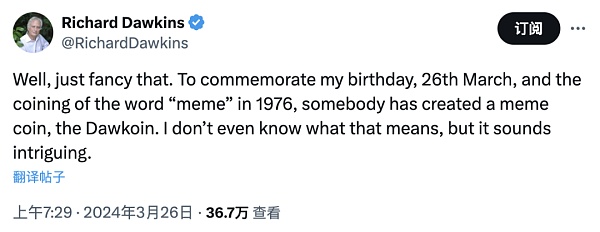
1.2 Bitcoin is the earliest MEME
"In a sense, all crypto tokens have MEME content, but the content is different. More than 50% is the norm." This is the view recently expressed by Blue Fox Notes, one of the earliest media in the blockchain industry. If you look at it on a scale of 0-100, the MEME content represented by pepe and doge is above 99.9%; AI has 90% MEME content; BTC L2 has 80% MEME content; Defi has 30-50% MEME content.
So, can Bitcoin also be said to be the earliest MEME?
We all know that in January 2009, on a small server in Helsinki, Finland, Satoshi Nakamoto invented the Bitcoin system and mined the first block, which is also called the "Genesis Block". The first 50 Bitcoins were also announced. Technically speaking, Bitcoin is the key to unlocking the door to the blockchain, relying on technologies such as cryptography, distributed storage, and consensus mechanisms that have gradually matured over the past half century.
But now when people mention Bitcoin, they don’t only discuss its technical algorithm. As the first successful cryptocurrency, the philosophical meaning behind Bitcoin, the anonymous founder Satoshi Nakamoto, and the spirit of fighting the traditional financial system all give it meaning beyond technology.
So from this perspective, Bitcoin itself is the earliest MEME, which represents the pursuit of power, freedom and system change. This symbolism transcends its function as currency and becomes an icon of a cultural and social movement.
Some people also say that MEME coins are the "attention economy". The more attention-grabbing MEME coins are, the better MEME is. After 15 years of development, and after the price broke through an all-time high of $71,000, Bitcoin's market capitalization has jumped to $1.398 trillion, surpassing silver ($1.379 trillion) and becoming the eighth largest asset in the world. The percentage of the total market capitalization of cryptocurrencies represented by Bitcoin reached 49.8%, and Bitcoin occupies a strong dominant position in the encryption industry.
With the passage of the Bitcoin ETF and the rise of the Bitcoin ecosystem at the beginning of this year, more and more traders and investors are "returning to their roots" and investing their attention and liquidity into the Bitcoin ecosystem.
Bitcoin is the most attention-grabbing token in the crypto industry. From this perspective, why is Bitcoin not a MEME?
1.3 Inscriptions and NFT: “derivatives” of MEME
Since MEME can be regarded as a form of expression of genes, then MEME must be differentiated. This can also be found in the "Selfish Gene" by Richard Dawkins, the origin of MEME mentioned above. A certain theoretical basis: MEME and genes Similarities in transmission and evolution mechanisms, both are transmitted through the replication process, both experience selection pressure, and will mutate under certain conditions.
Looking back at the leading MEME coin in the crypto, DogeCoin was originally created as a concept of a lighter version of Bitcoin, with the popular "Doge" MEME (a picture of a dog named Shiba Inu, paired with inner monologue-style text) as its logo. Its founders did not expect that this joke-based currency would be "favored" by Musk and eventually become the MEME currency with the largest market value today.
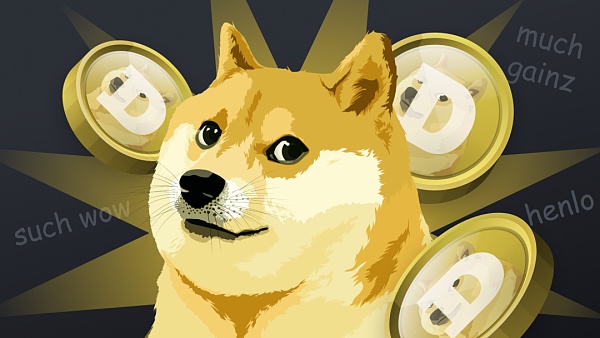
After twelve years of experience in the encryption industry, it has developed a set of usual logics. After creating new concepts and new narratives, project developers embrace and tie up with VC institutions, "roll their hair" with airdrops to warm up, and then Various games are played to allow the second level to take over. In this bull market, only TIA and SOL can be considered as good projects in Lao Jiucai's mind - there is a team, a good VC, Binance is online, and the track is expected to be hyped.
While all this should continue according to common sense, the MEME track has experienced a series of mutations and derivatives, and the inscription of "spoiler" was born. The emergence and popularity of all "inscriptions" in the Bitcoin ecosystem are completely unexpected.
Since its birth, "Inscription" has naturally carried the community spirit of "fair launch" and "first is first", which also happens to be MEME's slogan. Since its birth in March, bias has been closely associated with the Bitcoin ecosystem, but it seems that it has never given up convincing everyone: "If you are biased, then let the Bitcoin ecosystem grow until you have no bias."
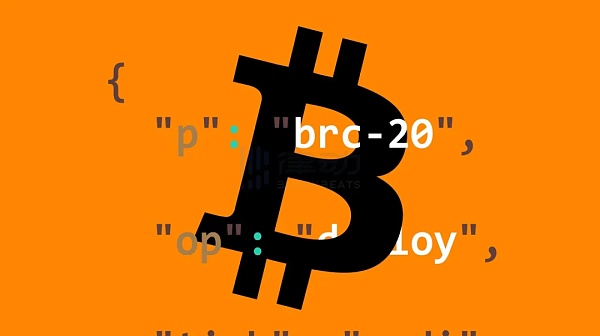
The cost of printing an ORDI (one card includes 1,000 coins) is 2 to 3 US dollars. Based on the current price of 1 ORDI of 60 US dollars, the current price of one ORDI is 60,000 US dollars. One year has passed. If it has not been sold yet, based on the current price, this is an investment that has increased more than 20,000 times.
In fact, inscriptions are not the first mutation and derivation of MEME. The diversity of MEME can also be reflected in the NFT track. As the biggest new narrative in the last cycle, NFT has also experienced a bull and bear cycle. The NFT leader BAYC once fell below 13 ETH, not to mention the current situation of more NFT artists without capital support, so they are also looking for themselves Various ways out.
It can also be seen from the recent popularity of BOME and SLERF that the cultural value that MEME coins bring to holders can also feed back the liquidity of NFT to a certain extent. Although the forms presented are different, the cultural attributes spread by NFT and MEME coins are essentially the same.
In addition to this broader form of derivation, we can also see the cultural derivation of the series in some more specific MEMEs, such as Pepe the Frog.
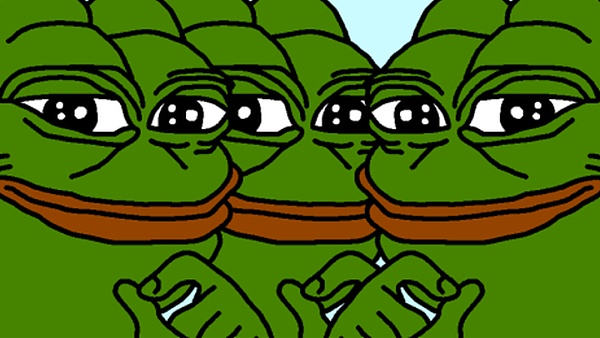
The image started out as a character in a 2005 online comic by cartoonist Matt Furie, but it has since evolved into a widely recognized meme symbol on the internet. Unlike MEMEs that have clear creator backgrounds, Pepe the Frog has a community of countless anonymous artists who have created a variety of Pepe images that are used in different cultural contexts and social media platforms. Playing various roles.
The evolution of Pepe the Frog demonstrates a unique phenomenon in MEME culture: how a single image can spawn a large and diverse cultural ecology. This cultural derivation is not just a simple act of copying the original image, but a process involving creative reconstruction and cultural reinterpretation.
2. The flowing crypto narrative and the iron-clad MEME culture
When delving into the nature of MEME and its relationship with blockchain, we discovered that the two work together to build a unique cultural and emotional ecosystem in the crypto world. Blockchain is not only a technological innovation, it has also become a huge emotional field. MEME is not only an entertaining meme, it is also shaping the market narrative in the blockchain industry, attracting community participation, and promoting the increase in the value of cryptocurrency. plays an important role.
2.1 The crypto is a magnifying glass for emotions and narratives
Where there are people, there are rivers and lakes, and where there are rivers and lakes, there are emotions.
The crypto has crazy bubbles and K-lines that jump up and down. It is not only a gathering place for funds, but also an amplified emotional pressure cooker.
From investors' passion for future technologies to fear and greed about market fluctuations, blockchain, as an emerging technology and financial field, amplifies the influence of these basic human emotions, thereby affecting market dynamics and investment decisions.
MEME is inherently capable of conveying emotions, from fanaticism to panic. In the form of humor, irony or even exaggeration, MEME can quickly spread among communities and trigger emotional resonance, thereby invisibly affecting the direction of the market.
In a short period of time, a successful MEME can attract a lot of attention and discussion, thereby promoting investors' purchasing behavior, leading to a short-term increase in prices. This phenomenon is especially common in crypto markets, where market sentiment can often influence price movements to a large extent.
I remember Yuval Harari once said in the book "A Brief History of Humankind" that Homo sapiens initially exchanged interpersonal information with each other through "gossip" and methods, and learned about others by commenting on them, thus establishing a stable and close interpersonal organization. .
Later, people formed a common imagination through "telling stories" to build more general trust, such as religion, country, currency, company, etc. Likewise, individuals in crypto communities can develop strong group identities and goals through shared memes and narratives.
This kind of trust based on common imagination is the key factor for MEME to generate prices in the crypto, and it is also the reason why it can attract a large number of investors and users in the crypto to participate.
2.2 MEME does not need the public chain, the public chain needs MEME
From BTC to Solana chain, and later TON chain and Base chain, every popular public chain requires MEME coins to encourage and even create MEME culture.
The most representative one is Anatoly, a joint venture created by Solana. On the opening day of last year's Solana Community Annual Summit, which coincided with Halloween in the West, Anatoly appeared in a green dinosaur costume and became the most unique and eye-catching presence at the summit. Anatoly stood in front of everyone and introduced himself: "I'm Anatoly, and I'm a silly dragon." After saying this, Anatoly smiled sheepishly, and the entire audience was also amused.
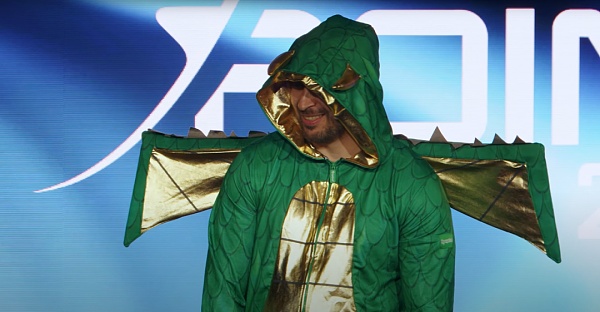
Everyone knows the story after that. Silly became the hottest MEME coin during that period. The community rediscovered that speculating on Solana was really smooth. The "Ethereum Killer" returned to the community's attention and became the "SBF Selection" .
After Solana, everyone discovered that it is feasible for public chains to build brand identity and community cohesion through MEME. A strong community built around a specific MEME can effectively promote the project, attract new users, and at the same time enhance the project's market position.
And now we can see that the TON chain and the Base chain are also ready to take a share of the trading liquidity of MEME coins. TVL has reached a new high, and the activity on the chain and the transaction volume on the chain have also increased exponentially. growth, and the TON Foundation also publicly announced that it is recruiting MEMECOIN ecological leaders.
2.3 Have we finally become disenchanted with concepts?
A recent joke: "Seeing the superposition of concepts like zk+DEPIN+rollup+ai, VCs in the crypto can't contain their excitement." Behind this joke, we can't help but think: Are we really interested in the cryptocurrency field? In-depth understanding and disenchantment of various concepts?
The continued popularity of MEME is like a mockery of the situation formed by these so-called inner circles. This irony not only questions the technology itself, but also criticizes the entire cryptocurrency market for its blind enthusiasm for new technologies and neglect of its substantive applications.
"I can't understand it anyway, so I might as well stir up MEMEs." The old leeks in the community seem to be unable to do what they want, and the new leeks are even less understanding. Under the narrative of the crypto that is rapidly iterating one after another, the MEME culture continues to flourish. The rapid listing of BOME on Binance has caused many crypto projects to "break their defenses". They have been working hard for several years but have not been able to get listed on the exchange, but BOME did it in three days.
Let’s go back to the question that the community often asks recently: “Is the end of the blockchain the MEME?” Or is “Value investing dead, MEME eternal?”. Although the formulation of these questions seems absolute and even a bit extreme. But we have to admit that the biggest role of blockchain in ten years will still be speculation, which may be true.





